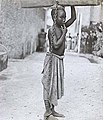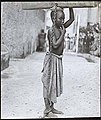Faịlụ:Slavezanzibar2.JPG

Otu nyochaa a ha:400 × 600 piksels Ndị ọzọ mkpebi:160 × 240 piksels | 320 × 480 piksels | 683 × 1,024 piksels.
Failụ si na nke mbu (683 × 1,024 pixel, ívù akwukwo orunótu: 68 KB, MIME nke: image/jpeg)
Ịta nke usòrò
Bìri èhì/ogè k'ị hụ òtù ụ̀fa dị̀ m̀gbè ahụ̀.
| Èhì/Ogè | Mbọ-aka | Ógólógó na asaá | Òjìème | Nkwute | |
|---|---|---|---|---|---|
| dị ùgbu â | 04:35, 19 Febụwarị 2014 |  | 683 × 1,024 (68 KB) | Jbarta | higher resolution |
| 21:21, 21 Septemba 2011 |  | 242 × 283 (27 KB) | Cropbot | upload cropped version, operated by User:Finavon. Summary: border cropped | |
| 09:44, 21 Eprel 2009 |  | 250 × 296 (18 KB) | File Upload Bot (Magnus Manske) | {{BotMoveToCommons|en.wikipedia|year={{subst:CURRENTYEAR}}|month={{subst:CURRENTMONTHNAME}}|day={{subst:CURRENTDAY}}}} {{Information |Description={{en|Photograph of a slave boy in Zanzibar. Taken c.1890. Unknown photographer. National Maritime Museum, Lo |
Ojiji faịlụ
Ihe ndị na-eso ihe eji Ihu akwụkwọ eme na faịlụ a:
Ejiji failụ zụrụ ọha
Wikis ndi a edeputara na eji kwa failụ a:
- Ihe eji na ar.wikipedia.org
- Ihe eji na bcl.wikipedia.org
- Ihe eji na bo.wikipedia.org
- Ihe eji na ca.wikipedia.org
- Ihe eji na cs.wikipedia.org
- Ihe eji na en.wikipedia.org
- Ihe eji na en.wikiquote.org
- Ihe eji na en.wikiversity.org
- Ihe eji na eo.wikipedia.org
- Ihe eji na es.wikipedia.org
- Ihe eji na eu.wikipedia.org
- Ihe eji na fi.wikipedia.org
- Ihe eji na fo.wikipedia.org
- Ihe eji na fr.wikipedia.org
- Ihe eji na fy.wikipedia.org
- Ihe eji na gl.wikipedia.org
- Ihe eji na he.wikipedia.org
- Ihe eji na hr.wikipedia.org
- Ihe eji na ht.wikipedia.org
- Ihe eji na hy.wikiquote.org
- Ihe eji na id.wikipedia.org
- Ihe eji na it.wikipedia.org
- Ihe eji na jam.wikipedia.org
- Ihe eji na ja.wikipedia.org
- Ihe eji na la.wikipedia.org
- Ihe eji na lt.wikipedia.org
- Ihe eji na mk.wikipedia.org
- Ihe eji na mt.wikipedia.org
- Ihe eji na nn.wikipedia.org
- Ihe eji na no.wikipedia.org
Lee more global usage of this file.
